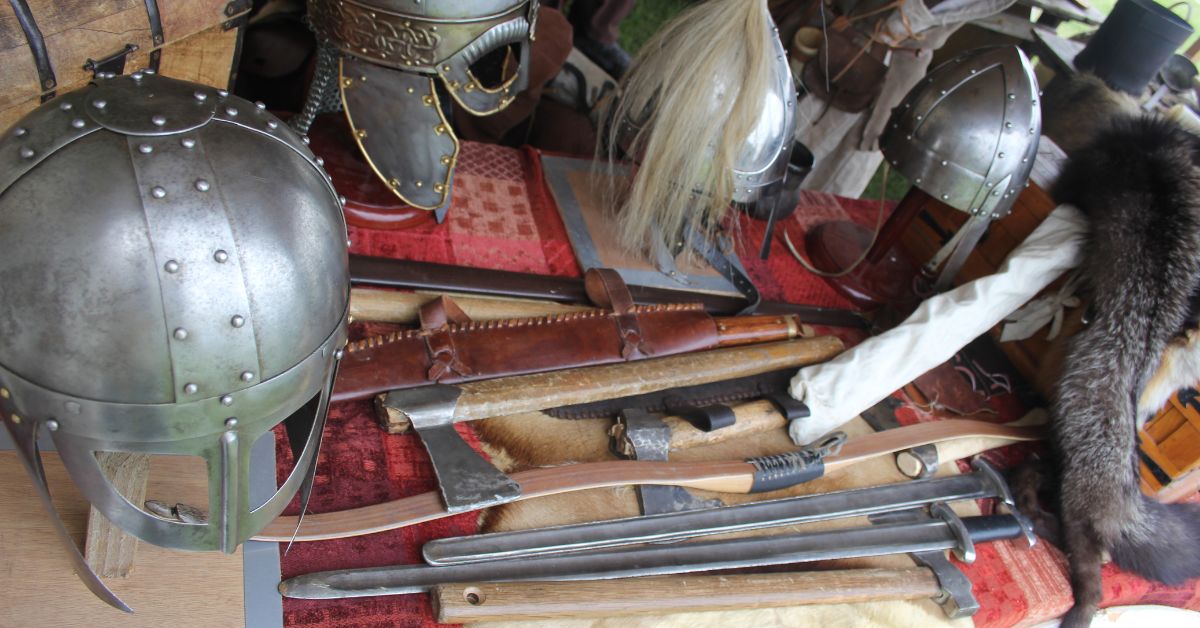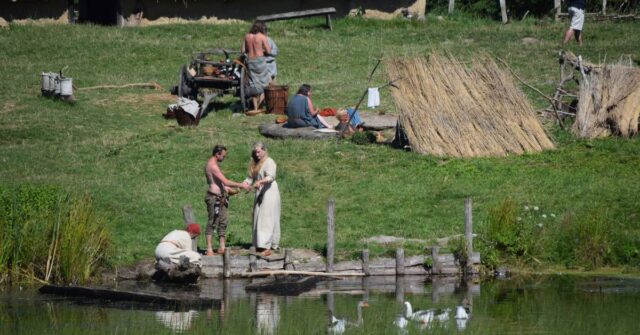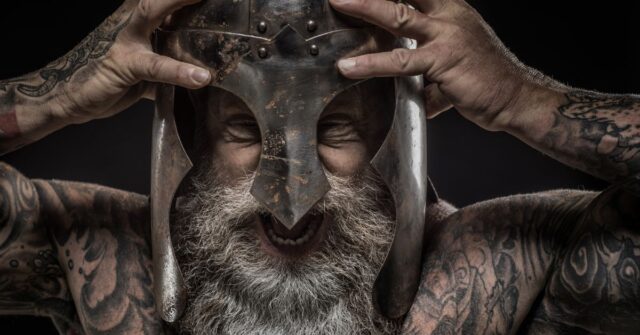The Vikings are celebrated not only for their seafaring conquests and warrior prowess but also for their exceptional craftsmanship.
This blog explores the artistry and skill behind Viking tools and weapons, delving into the materials, techniques, and cultural significance that made these artifacts both practical and symbolic.
Introduction
The Vikings, seafaring warriors from Scandinavia, are renowned for their exceptional craftsmanship in creating tools and weapons.
These artifacts were not just instruments of war and daily life but also symbols of status, power, and cultural identity.
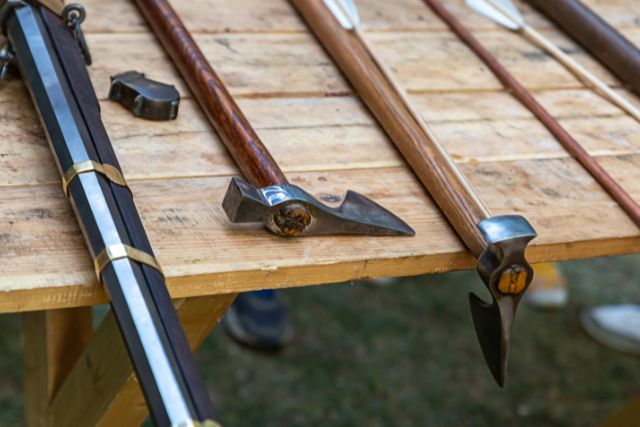

Materials Used in Viking Craftsmanship
Viking artisans were masters of utilizing the natural resources available to them. They sourced various materials, including iron, bronze, antler, and wood, each chosen for its unique properties.
The selection of these materials was critical to the functionality and durability of the tools and weapons they created.
Iron: The Backbone of Viking Weaponry
Iron was the most prevalent material in Viking weapon and tool making.
Extracted from bog iron deposits, it was strong and relatively abundant. Viking blacksmiths used iron to forge swords, axes, and spears.
The process involved heating the iron in a furnace with charcoal to remove impurities and then hammering it into shape.
The resulting weapons were durable and effective, although prone to rust, which required regular maintenance.
Bronze: Decorative and Functional Uses
Bronze, an alloy of copper and tin, was used for both decorative and functional purposes. It was less common than iron but prized for its resistance to corrosion and its aesthetic appeal.
Viking craftsmen used bronze for intricate decorations on weapons and for certain tools that required a finer touch.
Bronze items, such as brooches and fittings, often featured elaborate designs that showcased the artisan’s skill.
Antler and Bone: Crafting Handles and Decorations
Antler and bone were commonly used for handles and decorative elements. These materials were lightweight and easy to carve, making them ideal for creating detailed designs.
However, they were not as durable as metal, so they were often used for parts of tools and weapons that did not require as much strength, such as knife handles or inlays on larger weapons.
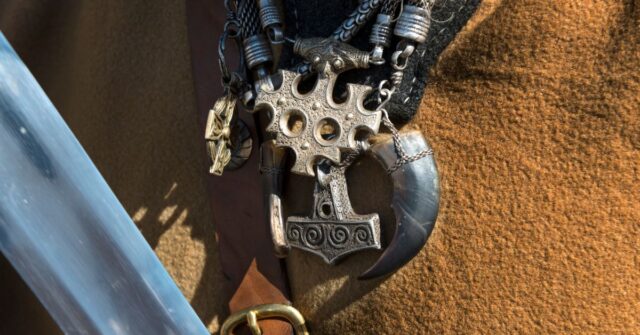

Wood: Versatility in Tools and Weaponry
Wood was an essential material in Viking society, used for a variety of tools and weapons. Shields, spear shafts, and bows were primarily made from wood.
The choice of wood depended on the item’s intended use: yew and ash were preferred for bows due to their flexibility and strength, while harder woods like oak were used for shields and tool handles.
Crafting Techniques of Viking Artisans
The crafting of Viking tools and weapons required a combination of skill, knowledge, and innovation.
Artisans employed advanced techniques such as forging, pattern welding, and tempering to enhance the strength and functionality of their creations.
Their ability to incorporate intricate designs and symbolic decorations further highlighted their craftsmanship.
Forging Iron and Steel
The forging process was fundamental to Viking craftsmanship. Blacksmiths heated iron and steel to high temperatures before hammering them into shape.
This process not only shaped the metal but also strengthened it by aligning its grain structure. The skill of the blacksmith was crucial, as improper forging could result in weak or brittle weapons.
Pattern-Welding: Creating Stronger Blades
Pattern welding was a sophisticated technique used to create stronger and more flexible blades. It involved twisting and folding multiple layers of iron and steel, which were then forged together.
This process produced distinctive patterns on the blade, which were both functional and decorative. The resulting weapons, such as the famous Ulfberht swords, were highly prized for their superior quality.
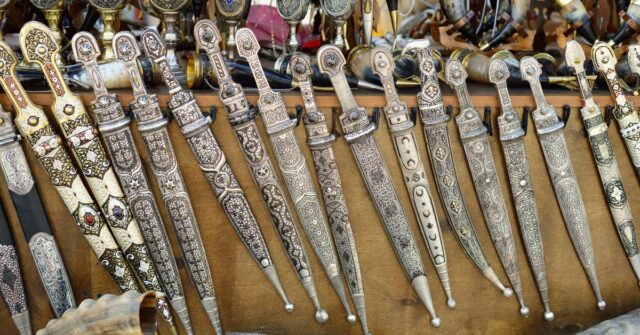

Carving and Decoration: Symbolism in Craftsmanship
Viking artisans were renowned for their intricate carvings and decorations. These designs were not merely ornamental; they held deep symbolic meanings.
For example, weapons often featured animal motifs and knotwork believed to have protective or magical properties. This level of detail required a high degree of skill and was a mark of a master craftsman.
Tempering: Enhancing Durability and Functionality
Tempering was a critical step in the manufacturing process that enhanced the durability and functionality of metal tools and weapons.
After forging, the metal was reheated to a specific temperature and then rapidly cooled.
This process increased the metal’s hardness and toughness, making it more resistant to damage in battle or everyday use.
Types of Viking Weapons
Viking weapons were diverse, reflecting the needs and strategies of their society. From swords to axes, spears, and bows, each weapon had specific uses in both combat and daily life.
The craftsmanship of these weapons also signified the status and prowess of their owners, making them integral to Viking culture.
Swords: From Early Designs to the Iconic Viking Sword
Viking swords evolved significantly over time. Early designs were simple and functional, but as techniques advanced, swords became more elaborate.
The iconic Viking sword featured a double-edged blade and a decorated hilt. These swords were often passed down through generations, becoming family heirlooms that symbolized strength and heritage.
Axes: Varieties and Uses in Battle and Daily Life
Axes were versatile tools in Viking society, used both in battle and for everyday tasks. Battle axes varied in size and design, from small hand axes to large two-handed axes.
The bearded axe, with its extended lower blade, was particularly effective in combat, allowing warriors to hook and pull shields or limbs. In daily life, axes were essential for woodworking and building ships.
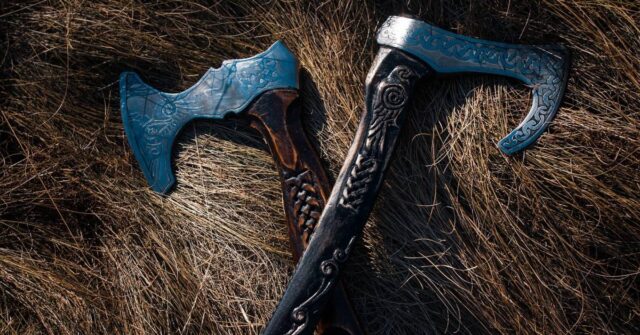

Spears: Versatility and Sacred Significance
Spears were among the most common Viking weapons, valued for their versatility. They could be used for thrusting in close combat or thrown as projectiles.
Spears were also deeply symbolic, often associated with Odin, the chief god in Norse mythology. This sacred connection made the spear not just a weapon but a symbol of divine power.
Bows and Arrows: Ranged Combat Tools
Bows and arrows were crucial for hunting and warfare. Viking bows were typically made of yew, ash, or elm, and arrows were crafted from lightweight woods like birch.
These weapons allowed Vikings to strike from a distance with precision. Archery was a highly valued skill, and many sagas recount the exploits of legendary archers.
Seaxes: The Viking Knives
Seaxes were single-edged knives used for a variety of purposes, from combat to daily chores. These knives were typically about a foot long, with a straight or slightly curved blade.
They were practical tools for cutting and carving, and their simplicity made them accessible to all members of Viking society.
Types of Viking Tools
In addition to weapons, the Vikings crafted a variety of tools essential for farming, carpentry, and household tasks.
These tools not only facilitated everyday activities but also showcased the ingenuity and resourcefulness of Viking craftsmen.
Each tool was designed to be effective and durable, reflecting the harsh environments in which the Vikings lived.


Farming Tools: Essential for Daily Survival
Farming tools were vital for Viking communities, which relied heavily on agriculture. Plows, hoes, and sickles were commonly used to cultivate the land.
These tools were typically made of wood with iron blades, designed for efficiency and durability. The ability to produce and maintain such tools was crucial for sustaining Viking settlements.
Carpentry Tools: Building Ships and Structures
Carpentry was an essential skill in Viking society, particularly for shipbuilding. Tools like axes, adzes, saws, and chisels were used to construct the famous Viking longships, as well as homes and other structures.
The craftsmanship of these tools was evident in the intricate and sturdy designs of Viking ships, which were key to their success in exploration and trade.
Household Tools: Everyday Items for Viking Life
Viking households utilized a range of tools for daily tasks, including cooking, weaving, and leatherworking. Items like knives, hammers, and spindles were common in Viking homes.
These tools were often passed down through generations, reflecting the importance of maintaining essential skills and resources within the family.
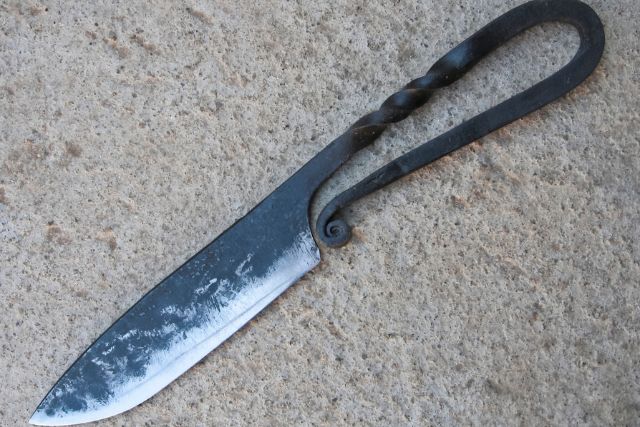

Symbolism and Mythology in Viking Weapons and Tools
Viking weapons and tools were imbued with rich symbolism and mythological significance.
The designs and decorations often featured motifs related to Norse gods and legends, believed to offer protection and power.
This symbolic dimension added layers of meaning to the practical uses of these items.
Religious and Mythological Significance
Viking weapons and tools were often imbued with religious and mythological significance. Many items bore symbols and motifs related to Norse gods and legends.
For example, Thor’s hammer, Mjölnir, was a powerful symbol of protection and strength, frequently depicted on weapons and amulets.
Such symbols were believed to confer divine favor and protection on their owners.
Symbolic Designs: Representing Power and Status
Beyond their practical uses, Viking weapons and tools often served as status symbols. Intricate designs and decorations indicated the owner’s social standing and accomplishments.
For instance, a warrior’s sword might feature elaborate patterns and inscriptions, showcasing both the skill of the craftsman and the status of the wielder.
These designs were not just ornamental but carried deep cultural meanings.
Evolution of Viking Craftsmanship
Viking craftsmanship evolved significantly over time, influenced by interactions with other cultures and advancements in technology.
Early tools and weapons were simple and utilitarian, but as the Vikings expanded their horizons, they adopted new materials and techniques, leading to more sophisticated and efficient designs.
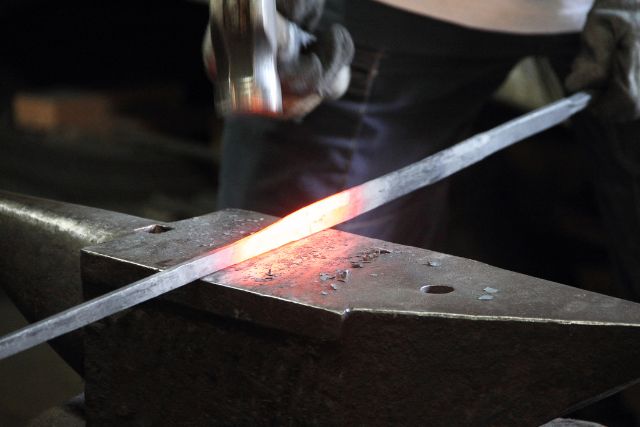

Early Designs: Simple and Practical
The earliest Viking tools and weapons were straightforward and utilitarian, designed primarily for effectiveness.
These items were made using basic forging techniques and were devoid of elaborate decorations. However, they were highly functional, reflecting the practical needs of early Viking society.
Influences from Other Cultures
As Vikings expanded their trade routes and came into contact with other cultures, they adopted and adapted new techniques and materials.
This cross-cultural exchange led to innovations in weapon and tool design. For example, the influence of Frankish swords resulted in longer, more refined blades that combined strength with flexibility.
Advancements in Techniques and Materials
Over time, Viking artisans developed more advanced techniques and experimented with different materials.
Innovations like pattern welding and the use of steel for blade edges improved the quality and durability of weapons.
These advancements allowed Vikings to create more sophisticated and effective tools and weapons, enhancing their capabilities in both warfare and daily life.
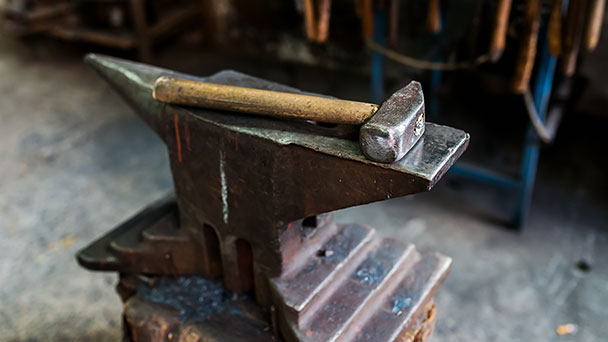

Archaeological Discoveries and Their Insights
Archaeological excavations have provided a wealth of information about Viking craftsmanship.
Discoveries from burial sites and settlements offer insights into the materials, techniques, and cultural significance of Viking tools and weapons.
These findings help us understand the daily lives and societal structures of the Viking Age.
Significant Finds in Viking Burial Sites
Archaeological excavations of Viking burial sites have unearthed numerous weapons and tools, providing valuable insights into Viking craftsmanship.
These finds often include well-preserved swords, axes, and other artifacts that shed light on the materials and techniques used by Viking artisans.
For example, the discovery of the Gokstad and Oseberg ship burials in Norway revealed not only the ships themselves but also a wealth of tools and weapons buried with the deceased, indicating their status and the importance of these items in Viking society.
Preservation and Analysis of Artifacts
The preservation of Viking artifacts allows researchers to analyze the construction methods and materials used.
Techniques such as X-ray fluorescence (XRF) and metallographic analysis have been employed to study the composition and microstructure of metal objects, revealing details about the forging and tempering processes.
These analyses help historians understand the technological advancements and trade practices of the Viking Age, as well as the everyday lives of the people who used these tools and weapons.
What These Discoveries Tell Us About Viking Life
Archaeological discoveries provide a window into Viking life, illustrating the roles that tools and weapons played in both daily activities and broader cultural contexts.
The presence of elaborately decorated items in burials suggests that these objects were not only functional but also held significant symbolic meaning.
Additionally, the variety of tools found—ranging from agricultural implements to woodworking tools—highlights the diverse skills and occupations within Viking communities.
These artifacts reveal a society that valued craftsmanship, resourcefulness, and the symbolic power of their tools and weapons.
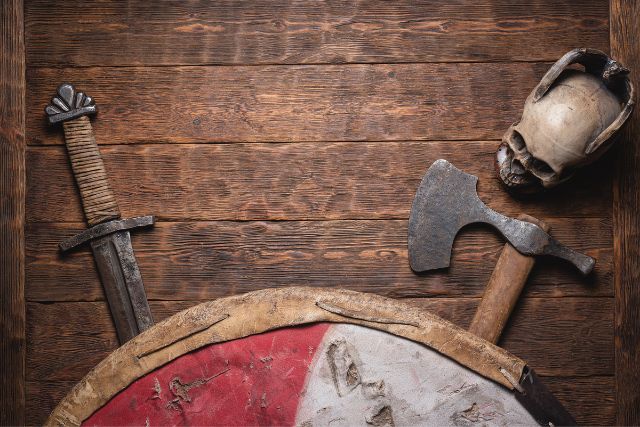

The Legacy of Viking Craftsmanship in Modern Times
The influence of Viking craftsmanship extends into modern times, inspiring contemporary artisans and appearing in popular culture.
The techniques and designs developed by Viking craftsmen continue to be admired and replicated, preserving the legacy of their skill and creativity.
Influence on Modern Tools and Weapons
The legacy of Viking craftsmanship is evident in modern tools and weapons, which often draw inspiration from the techniques and designs of the past.
Contemporary blacksmiths and craftsmen study Viking methods to replicate the strength and beauty of these ancient artifacts.
The use of pattern welding, for example, has seen a resurgence in modern blade-making, producing knives and swords with both functional and aesthetic qualities.
This ongoing influence underscores the enduring appeal of Viking craftsmanship and its relevance in today’s world.
Viking Symbolism in Contemporary Culture
Viking symbolism continues to captivate the modern imagination, appearing in various forms of art, fashion, and media.
From movies and television series to video games and literature, Viking themes are popular and pervasive.
Symbols such as Thor’s hammer and the Valknut are frequently incorporated into jewelry and clothing, reflecting a fascination with Norse mythology and heritage.
This cultural revival keeps the spirit of Viking craftsmanship alive, connecting modern audiences with the artistry and symbolism of the Viking Age.


Re-enactments and Replicas: Keeping the Tradition Alive
Historical re-enactments and the creation of replicas play a crucial role in preserving Viking craftsmanship.
Enthusiasts and historians work diligently to recreate Viking weapons, tools, and clothing using traditional methods and materials.
Events such as Viking festivals and re-enactment groups provide immersive experiences that educate the public about Viking life and skills.
These activities not only honor the legacy of Viking artisans but also ensure that their techniques and knowledge continue to be appreciated and understood by future generations.
Conclusion
The craftsmanship of Viking tools and weapons is a testament to the skill and ingenuity of these ancient people.
Through careful selection of materials, advanced forging techniques, and intricate decorative designs, Viking artisans created items that were both practical and symbolic.
Archaeological discoveries continue to reveal the depth and complexity of Viking craftsmanship, providing valuable insights into their culture and way of life.
The legacy of these skilled craftsmen endures in modern times, influencing contemporary tools and weapons and captivating the imaginations of people worldwide.
By studying and preserving Viking craftsmanship, we honor the rich heritage and enduring impact of these remarkable artisans.
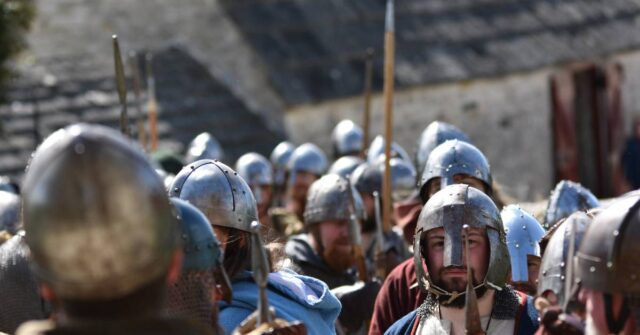

Frequently Asked Questions
In exploring Viking craftsmanship, several common questions arise.
From the wages of Viking craftsmen to the training methods and superstitions surrounding their tools and weapons, these inquiries help illuminate the practical and cultural aspects of Viking society.
What Were the Typical Wages of Viking Craftsmen?
Viking craftsmen were often compensated through a barter system, as monetary wages were uncommon during the Viking Age.
Skilled blacksmiths, shipbuilders, and jewelers could command high value for their work, receiving goods such as livestock, food, and even land in exchange for their services.
The value of their work was recognized and respected, reflecting their essential role in Viking society.
How Did Viking Craftsmen Learn Their Skills and Techniques?
Viking craftsmen typically learned their skills through apprenticeship and familial traditions. Young apprentices would train under experienced craftsmen, learning the techniques and secrets of the trade.
This hands-on training was crucial for mastering the intricate skills required for metalworking, woodworking, and other crafts.
Knowledge was passed down through generations, ensuring the continuity and refinement of Viking craftsmanship.
Did Vikings Have Any Specific Superstitions or Beliefs Surrounding Their Weapons and Tools?
Vikings held various superstitions and beliefs regarding their weapons and tools.
Many items were thought to possess spiritual qualities or protective powers, often reflected in the symbols and runes inscribed on them.
For instance, a warrior might believe that his sword was imbued with the spirit of a past ancestor, providing strength and guidance in battle.
These beliefs added a layer of personal and cultural significance to their weapons and tools.


What Was the Average Lifespan of a Viking Weapon or Tool?
The lifespan of a Viking weapon or tool varied depending on its use and maintenance.
Weapons used in combat, such as swords and axes, could be damaged or worn out relatively quickly, especially if not properly maintained.
However, well-crafted and well-maintained tools and weapons could last for many years, even being passed down through generations as heirlooms.
Regular care, including cleaning and sharpening, was essential for prolonging the life of these items.
Were Certain Types of Weapons Reserved for Specific Classes or Ranks Within Viking Society?
While there were no strict rules, certain types of weapons were often associated with higher social status.
For example, swords, which required significant resources and skill to produce, were typically owned by wealthier individuals or warriors of higher rank.
Commoners and lower-ranking warriors were more likely to use axes and spears, which were easier and less costly to manufacture.
This association of weapon types with social status reflected the broader hierarchies within Viking society.

